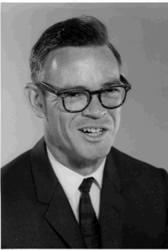

|

|
IN MEMORIAM
James A. Harder
Professor of Civil Engineering, Emeritus
UC Berkeley
1926 – 2006
Professor James (Jim) Harder died December 31, 2006 in Oklahoma at the age of 80. Jim was born in Fullerton, California, December 2, 1926. He enrolled in the California Institute of Technology (Cal Tech), Pasadena, in the fall of 1944 and received a B.S. (with honors) in mechanical engineering in 1948. His schooling was interrupted by service in the United States Navy during the period 1945-46 as an electronics technician.
Following graduation from Cal Tech he worked as a design hydraulic engineer with the U.S. Soil Conservation Service. In 1950 he entered the graduate program in civil engineering at the University of California, Berkeley, receiving the M.S. degree in 1952. Professor Harder then continued his graduate studies, receiving a Ph.D. degree in 1957 in mechanical engineering in the area of fluid mechanics. During this period he worked as a teaching associate and research engineer. In 1957 he was appointed assistant professor in mechanical engineering (50%) and civil engineering (50%); his position was changed in 1959 to full time in civil engineering, where he continued as associate professor (1961) and professor (1970) to his retirement in October 1991.
Jim taught a number of different courses at both the undergraduate and graduate levels in civil engineering. Undergraduate courses included elementary fluid mechanics, advanced hydraulics, design of hydraulic structures and systems, computer programming, and hydraulic laboratory practice; graduate courses included sediment transport mechanics, computational methods in non-steady flow, surface water hydrology, numerical analysis, and electronic instrumentation for hydraulic research.
In the undergraduate hydraulic laboratory course Jim introduced design considerations along with the laboratory experiments and related them to actual field examples. Information on projects in progress were obtained from local public works departments and used by the students to develop designs and test these designs using models which they constructed. An example is the spillway for the Marin County Water District’s Soulajule Dam, which was redesigned from the original and actually constructed by the district.
Jim’s research in the fluid mechanics/hydraulics area was broad-ranging and innovative. His publications, while not numerous, were of high quality. Topics included fluid mechanics at river bends, sustained swimming speeds of dolphins, analog simulators for flood control systems, the identification of time-dependent nonlinear hydraulic systems, and the automatic control of irrigation control gates.
Before digital computers, Jim developed electric analog models simulating flows within San Francisco Bay and the Sacramento Delta, rating curves of rivers, nonlinear storage effects within river levees as well as in overbank flows, and reservoirs in which the water surface area was nonlinear with depth and from which programmable flow releases could be made. This development was a major advance. Using this approach, he devised a system that the U.S Army Corps of Engineers used to control flooding of the Kansas River; he also devised a system for the California Department of Water Resources for the Delta to combat salinity intrusions. His paper with H. Banks and R. Richter entitled “Sea Water Intrusion in California” received the best paper award in 1957 from the American Water Works Association.
The identification studies utilized sequences of concurrent input and output data to characterize the nonlinear response of hydraulic systems. They were applied to both the Suisun Bay (estuary salinity as a function of river flow) and the Mekong Delta (rise of flood waters due to interactions of rainfall and upstream river flows from prior 10 days). The research on automatic control of flows and control gates was applied by the Bureau of Reclamation to some of its systems.
Jim’s work also included studies of fish protection facilities. He served as vice chairman of the Consulting Board for Fish Protection Facilities for the California Department of Fish and Game, California Department of Water Resources, and the U.S. Bureau of Reclamation.
In the later stages of his career Jim became interested in the applications of fluid mechanics principles in the medical profession. He designed and conducted a feasibility study of an electrically driven artificial heart (1975). A few years later (1983) he worked with some doctors in Alaska and developed preliminary designs for a new type of endoscope which could be made more flexible to accommodate sharp changes in the orientation of the intestine. In addition he, together with a medical colleague, developed equipment and a procedure to eliminate the need for the external bag resulting from colostomy operations. At the time, cost for continued development was too high for potential sponsors.
Jim also was greatly interested in outer space and was a member of the Aerial Phenomena Research Organization, Inc. In 1968, for example, he presented testimony to the House of Representatives Committee on Science and Astronautics on “the UFO problem”. He sincerely believed that the earth has experienced extraterrestrial visitors.
Jim and his family resided for a number of years in the hill area north of and overlooking the Berkeley campus; he walked daily to and from campus. One of Jim’s colleagues stated that he would frequently say that he enjoyed this walk to the campus and considered it “to be the best time of his day”.
Jim is survived by his wife Cedar Carrier, currently living in Talequah, Oklahoma; two sons, David of Walnut Creek, California, and Thomas of Berkeley, California; and a daughter, Catherine Heilman of Aloha, Oregon.
Carl L. Monismith
Jerome F. Thomas
Robert L. Wiegel